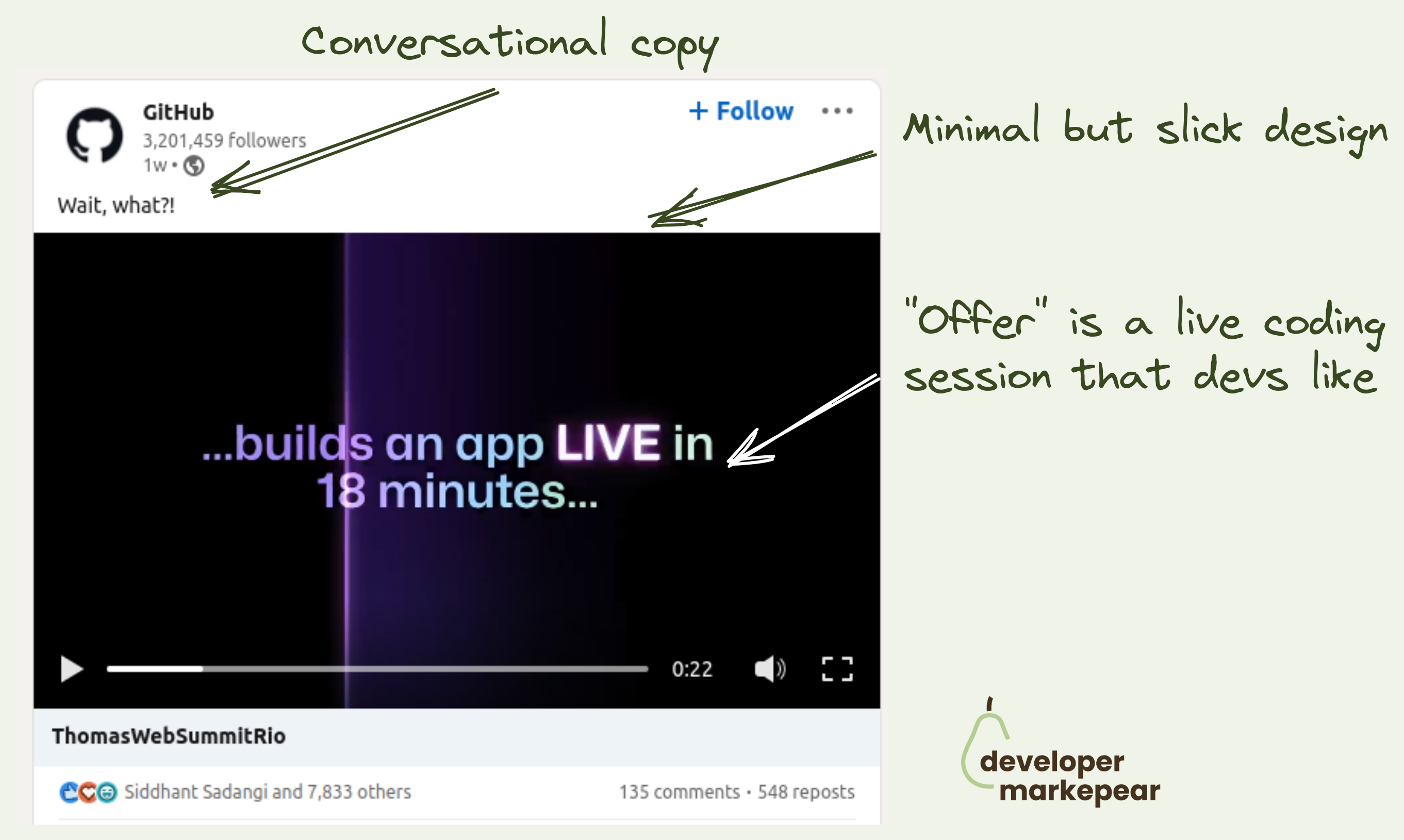
7k likes on an event promo post to the dev audience.
I don't think I've ever seen 7k likes on a developer company post on Linkedin.
Ok, this is Github, but still.
This is a 26sec video where they go:
This is a job well done:
And they could have done:
This is how to promote an event. LOVED IT!
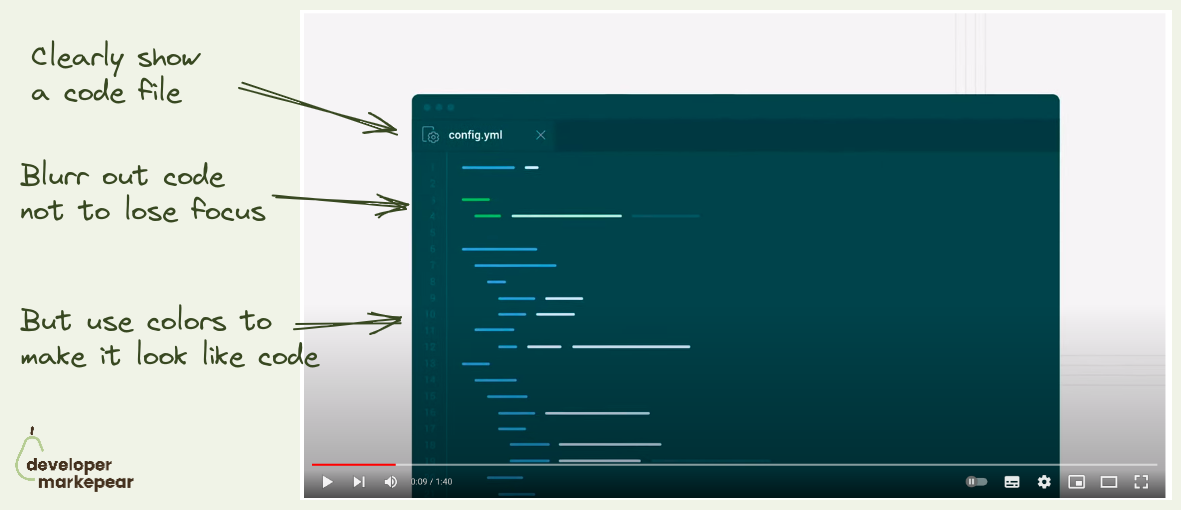
Showing code and UI in an explainer video is always a dance and rarely ends well.
You want to show the code to make it devy.
But you don't want to show everything not to overwhelm.
The same goes for UI which should look like your UI.
But show only what is necessary.
It's a struggle but CircleCI does it really nicely in this explainer:
They do the same for the UI later in the video.Just a really clean way of explaining things. Nice!

The homepage header is about landing your core product message.
For Modal it is basically LLM infrastructure with great developer experience.
And they do a great job delivering it:
Top job on that header folks!

Great above the fold
The subheader explains the value proposition.
Header handles major objections:
Then we have 3 CTAs but they are super focused on devs:
Then it goes on to explain how it works with a simple, static graphic.
This whole thing makes me feel peaceful.
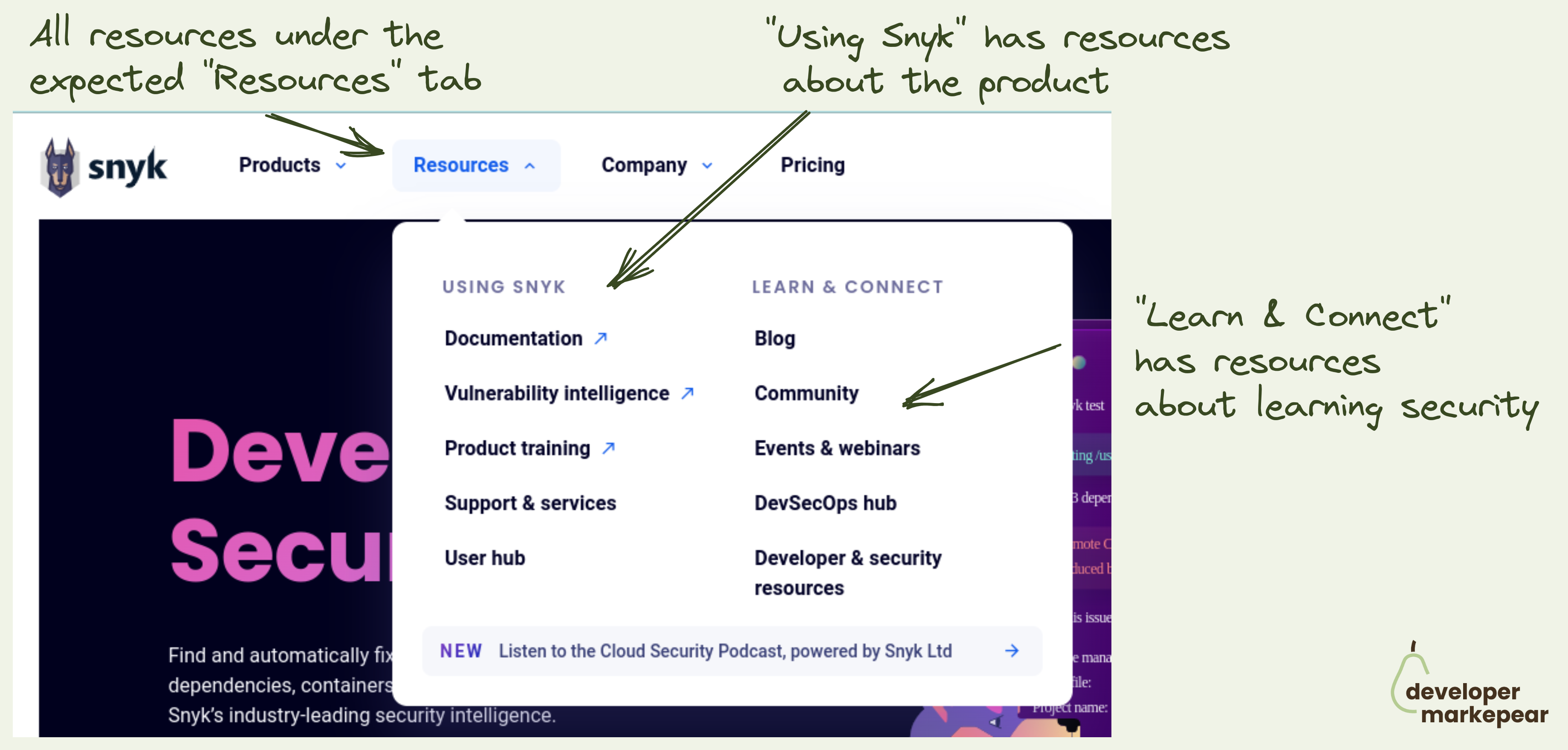
The "Resources" tab is the most loved and hated tab for developer marketers.
Ok so the common problem is that you have lots of different resources:
You want to showcase them in the navbar but where do you put them?
Under product? Company? Docs?
How to make sure that people don't go to your blog to read about your product just to find out that you talk about the industry problems there?
Enter the "Resources" tab. The "Miscellaneous" of the navbar world.
And typically it is just crammed with all stuff that doesn't fit anywhere. Just like any respectable misc folder would.
How do you deal with that?
Snyk approached it in a clear and logical way:
I love this (and already stole the idea for our site).
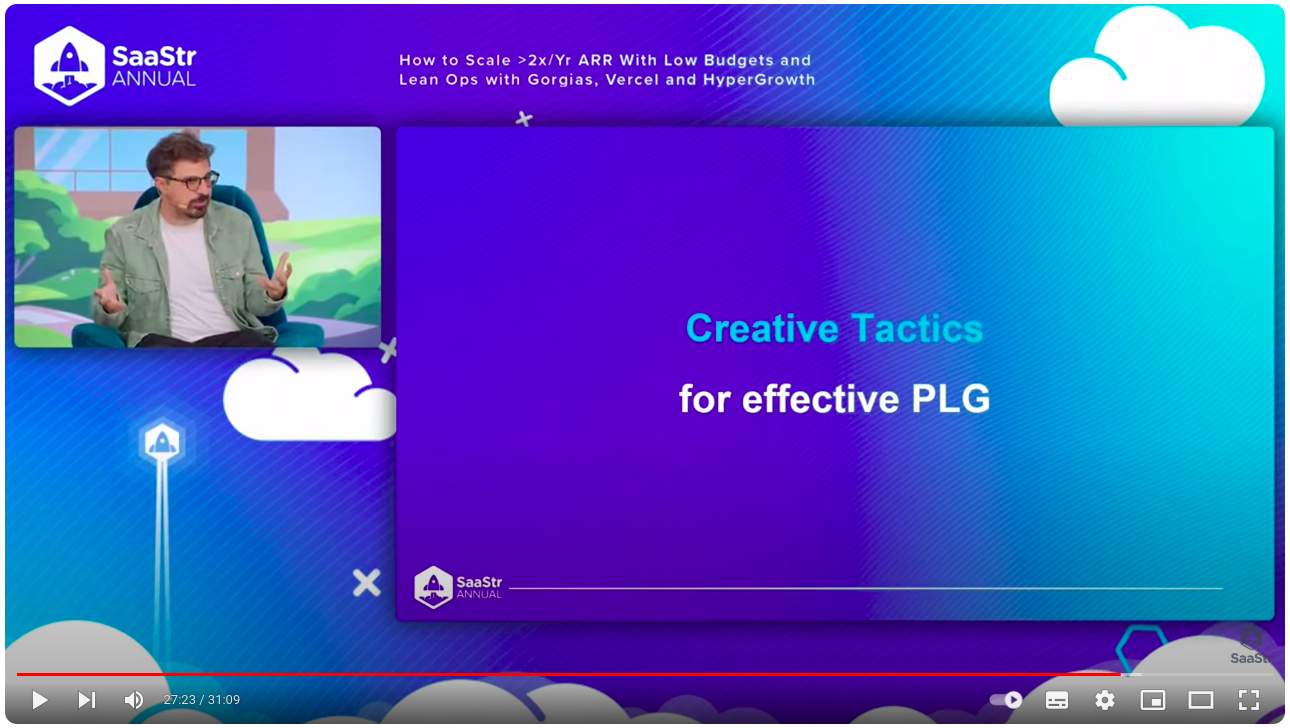
Gonto shared an interesting play that they tried at Auth0 when he was running growth there.
So the story goes like this:
I think that doing just the sponsorship for the retargeting pixel could work.
But when you add that branding consistency between the sponsored site and the product the CTR is better.
Interesting one for sure.

Many dev tools have complex pricing and packaging.
Say your dev tool/platform has many product offerings.
And you offer usage-based pricing but also enterprise plans but also per-product options, and additional customizations.
But you want to present it in a way that is manageable for the developer reading your pricing page.
Mux solves it this way:
Extended headers on pricing pages are not common as they add friction.
But sometimes adding friction is exactly what you need to do.
Mux managed to make this page (and their offering) easy to navigate by adding a little bit of friction at the beginning.
Maybe you don't browse plans right away but at least you don't waste energy (and attention) on the parts of the page that doesn't matter to you.
Good stuff.

Fantastic all-text Reddit ad from Latitude.
Dev ads are hard. Promotion on Reddit is harder. Running a dev ad on Reddit that gets 50 comments and 90 likes is expert-level hard.
But folks from Latitude managed 🔥
They used one of my favorite Reddit ad formats: all text.
Here is what I liked:
Great execution. Chapeau bas Latitude.

This is one of my favorite our dev tool vs competitor blog posts.
With these pages, you want to explain when you are better.
But you don't want to berate your competitor.
And above all, you want to help people make a decision.
Chances are (almost 100% ;)) that you are not better for every use case. And your developer audience knows it.
But there should be use cases, tool stacks, or situations when you are the best option.
Talk about those. Dev to dev.
@Convex did a great job in this post that I think can be a template for how to write these:
After reading that post you are fairly convinced that if your situation matches the one described and if it makes sense to use it.
Love it.

This has to be one of the better dev-focused headers I've seen in a while.
Headers should deliver your core product message and get people interested. That is true at any stage but early stage especially.
💡You want everyone, even those folks who just take a look and leave to remember. You want them to recall it in their next conversation around this topic.
There may be supporting messages for sure but there is always that one core thing. Make sure it lands.
In the case of Clickhouse, that core message is that they are a database that is fast at a huge scale.
Their supporting messages are:
💚And they deliver that beautifully with:
Headline
Clear as day headline speaking to value delivered at a level that builds rapport with their audience.
Not "Give users seamless web experience at scale" but "Query billions of rows in milliseconds". I like that little touch with "rows" which makes who they speak to obvious
Subhead
Subhead supporting it with "fastest and most resource-efficient DB"
+ talking about the use cases "real time apps and analytics" and it being open-source
Calls to action
These CTAs make the audience feel at home. There are docs in there + clear "we are open-source" CTA
Visual
That supporting visual is just amazing.
It shows the value in the most believable way you could deliver it here imho. Query and an Output that shows the size of the database and speed of the query
Social proof
Social proof in the navbar, almost 34k stars and a GitHub icon.
+ a way to get people to that repository, check it out and leave a star.
There is more social proof below the fold with big logos and stuff but the GitHub icon and stars make it immediately clear that this is a project that people care about.
It is remarkable how brilliantly simple it is all presented. Just a fantastic work IMHO.
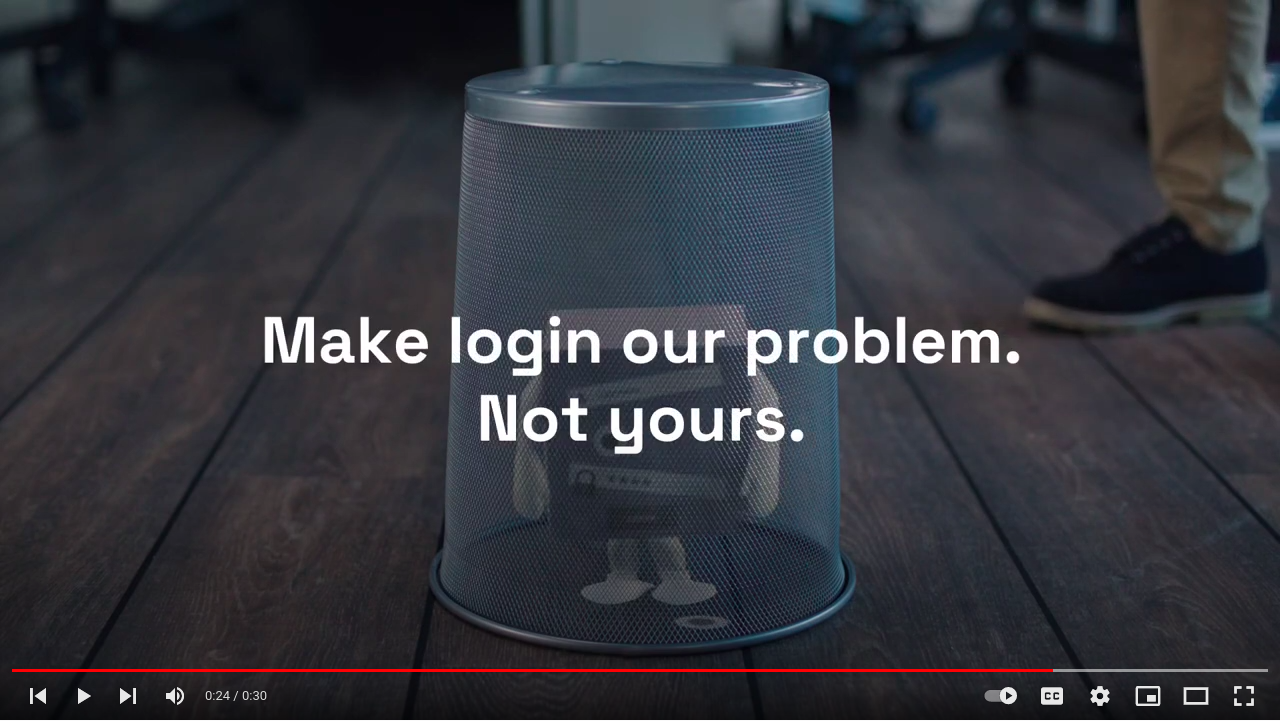
Make login our problem. Not yours.
This is a beautiful messaging of Auth0 solution.
Login
Simple explanation of what it does/gives you.
Simplified of course
Our problem. Not yours.
You "outsource" this boring but important problem to someone else.
It also has a feel of SaaS in there.
They will take care of it.
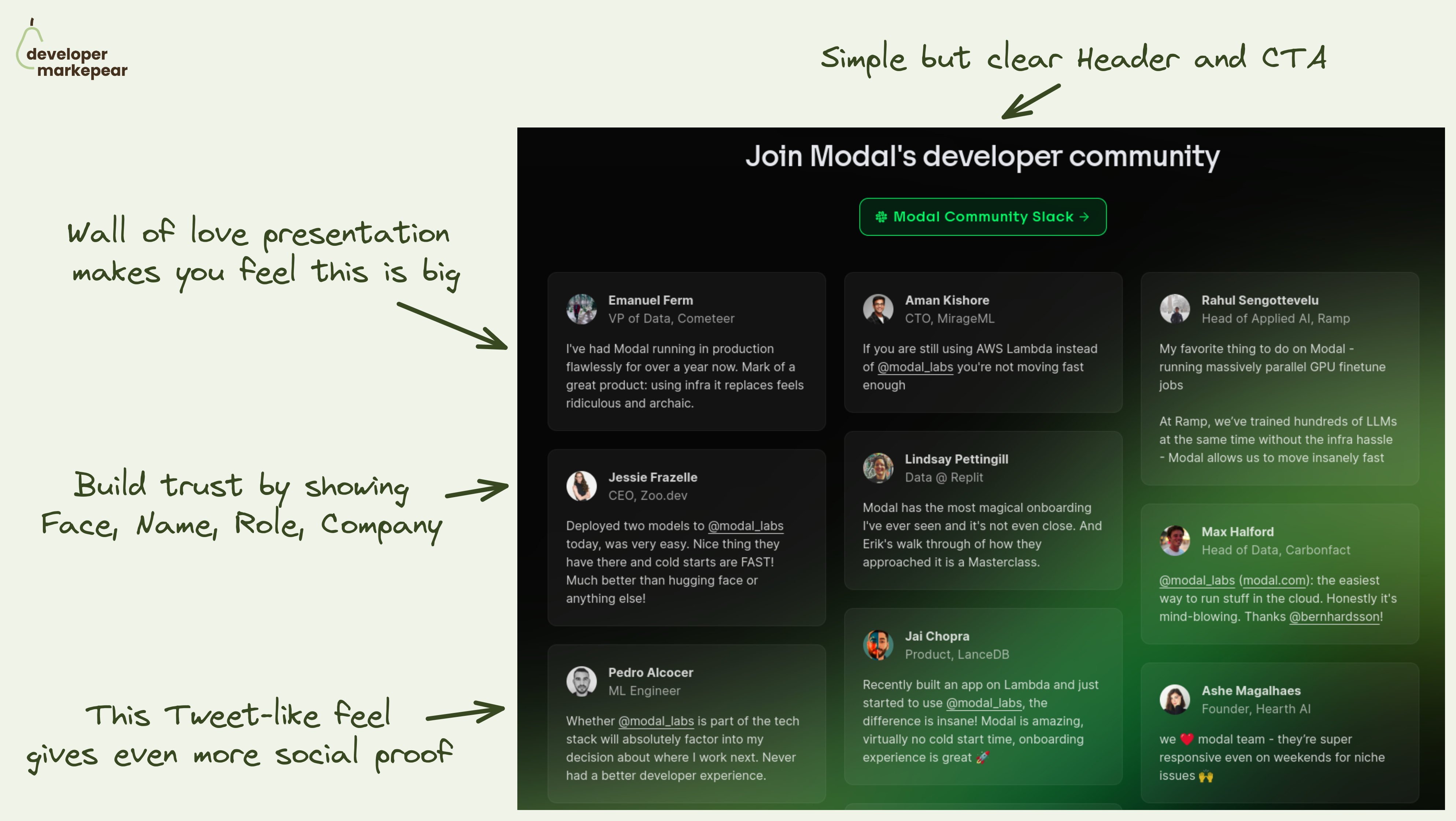
The main message you want to land on your homepage community section is:
"We have a big community of devs who love using the product"
🚧 That helps you tackle obstacles your dev reader has:
💚 Modal solves it beautifully by going simple but smart:
It lands the message that this section should land for sure. I really like it.

What to say when you have many products?
Dev tool companies over time grow from one product to suite of products to platforms with products built on top of the core one.
The result is that it is harder to communicate without going full-on fluff mode (my fav "built better software faster").
But for most companies, there is this core capability/product where people start. The entry product. Why not use that?
I really liked what Stripe did on their docs page here:
Even though this is docs, the same applies to homepages and other dev comms.
If you have many products, figure out what is the most important one, the one where most people enter. Focus on that. "Upsell" to other products later.

I like that this is both strong and subtle.
It comes right after I've delivered a smell of value with a technical intro.
And I can see that there is more value to come after thanks to the table of contents.
The CTA itself feels like an info box in the docs rather than a typical subscribe CTA.
Good stuff.
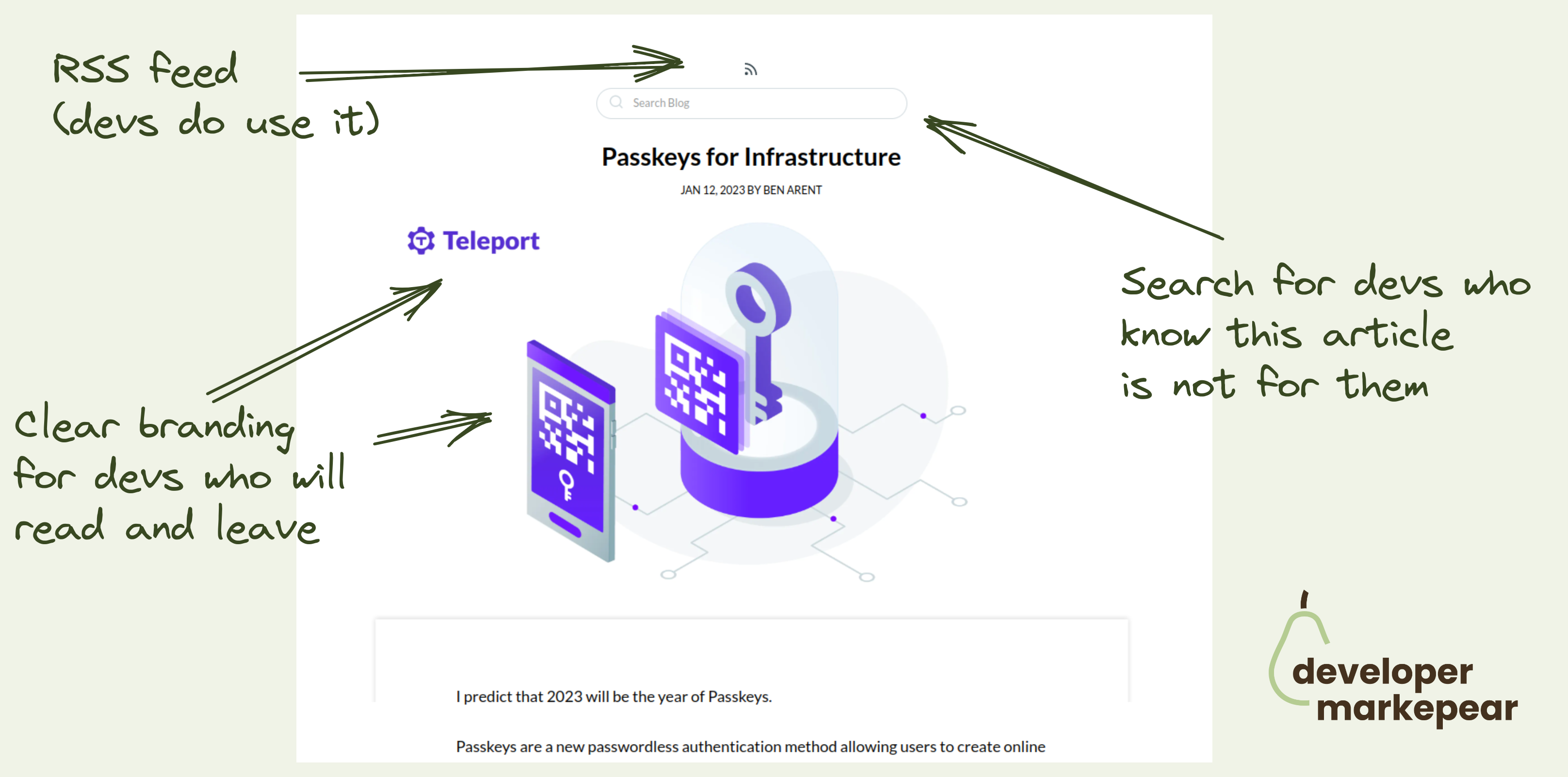
There are a few developer experience gems here:
Also, their design is super clean, non-invasive, and simple which makes for easy content consumption and more developer love.
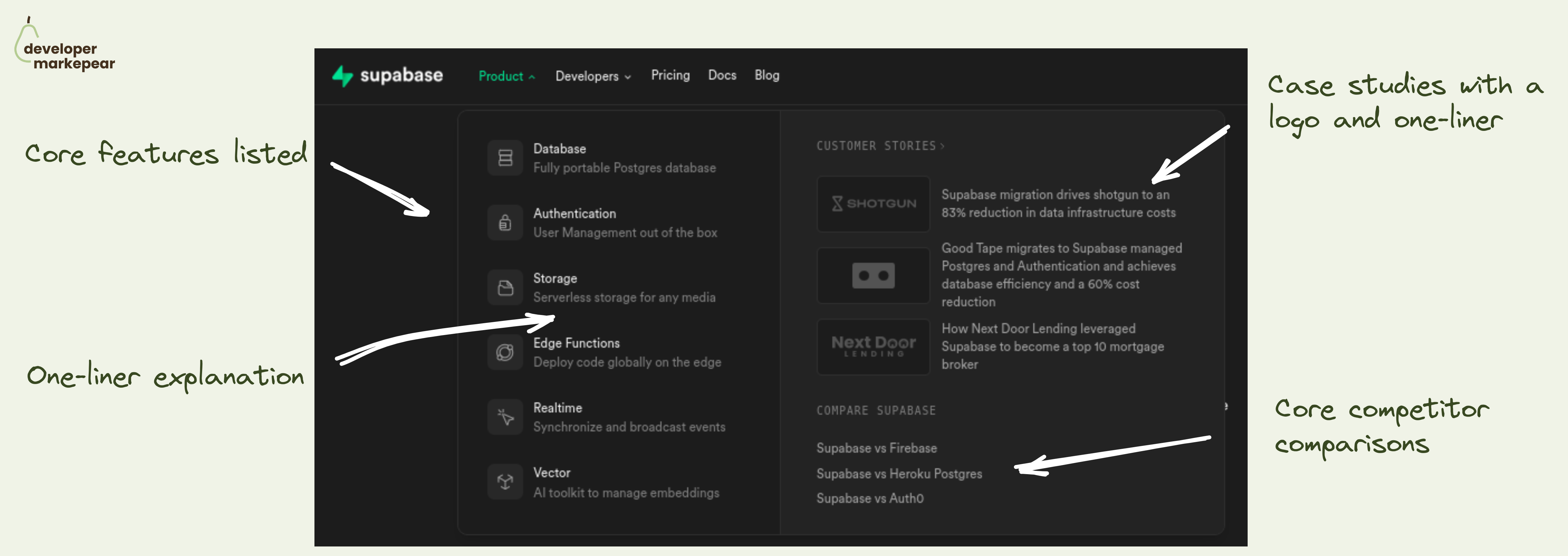
Really good product navbar tab from Supabase.
The product tab in your navbar is likely the most visited one on your site.
And there are a million ways of organizing information in there.
But ultimately, you want to help people understand what this product is about at a glance.
Even before they click. Even if they never click.
And how do you explain your product to devs?
By answering common questions:
Supabase does it really nicely:
Very solid pattern imho.
What I'd improve:

𝗛𝗼𝘄 𝘁𝗼 𝗰𝗿𝗲𝗮𝘁𝗲 𝗴𝗼𝗼𝗱 𝘁𝗲𝗰𝗵𝗻𝗶𝗰𝗮𝗹 𝗰𝗼𝗻𝘁𝗲𝗻𝘁 𝘁𝗵𝗮𝘁 𝘁𝗵𝗲 𝗛𝗮𝗰𝗸𝗲𝗿 𝗡𝗲𝘄𝘀 𝗮𝘂𝗱𝗶𝗲𝗻𝗰𝗲 𝗹𝗶𝗸𝗲𝘀?
The general tip is simple. Create content that the HN audience finds interesting.
𝗧𝗵𝗮𝘁 𝘁𝘆𝗽𝗶𝗰𝗮𝗹𝗹𝘆 𝗺𝗲𝗮𝗻𝘀:
But how do you actually do that?
𝗢𝗻𝗲 𝗼𝗳 𝘁𝗵𝗲 𝗽𝗹𝗮𝘆𝗯𝗼𝗼𝗸𝘀 𝘁𝗵𝗮𝘁 𝘀𝗼𝗺𝗲 𝘁𝗲𝗰𝗵𝗻𝗶𝗰𝗮𝗹 𝗳𝗼𝘂𝗻𝗱𝗲𝗿𝘀 𝗱𝗲𝗽𝗹𝗼𝘆𝗲𝗱 𝘄𝗮𝘀 𝘁𝗵𝗶𝘀:
That was exactly what folks from CockroachDB did at the beginning. Heard about it on one of the episodes of the Unusual Ventures podcast with Peter Mattis from Cockroach Labs.
𝗘𝘅𝗮𝗺𝗽𝗹𝗲𝘀 𝘁𝗵𝗮𝘁 𝗵𝗶𝘁 𝘁𝗵𝗲 𝘁𝗼𝗽 𝗼𝗳 𝗛𝗡:
• "CockroachDB Stability Post-Mortem: From 1 Node to 100 Nodes"
• "Serializable, lockless, distributed: Isolation in CockroachDB"
• "How CockroachDB Does Distributed, Atomic Transactions"
Kudos Cockroach Labs team and thanks for sharing!
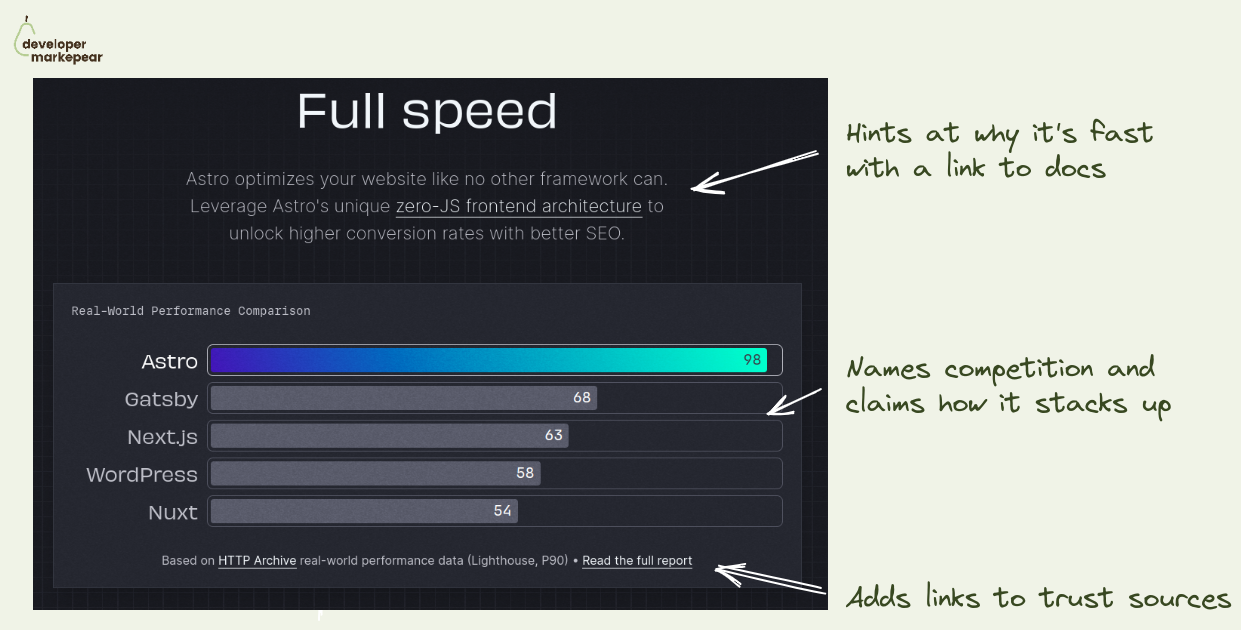
Your dev tool is faster/more scalable/more X -> show it with benchmarks.
For some tools the entire unique selling point is that they are faster.
You build your messaging around that, put a flavor of "fastest Y for X" in the header and call it a day.
But devs who come to your website cannot just take your word for it. They need to see it, test it.
For some tools it is possible to just see it for themselves, get started.
But you cannot expect devs to really take a database or an observability platform for a spin.
As to test the speed or scalability on realistic use case you need to...
... set up a realistic use case. Which takes a lot of time.
But you can set that use case and test it for them. With benchmarks.
I really like how Astro approached it:
If your usp is that you are faster/more scalable/ more whatever. Back it up. This is the nr 1 thing devs on your website need to trust you with to move forward.
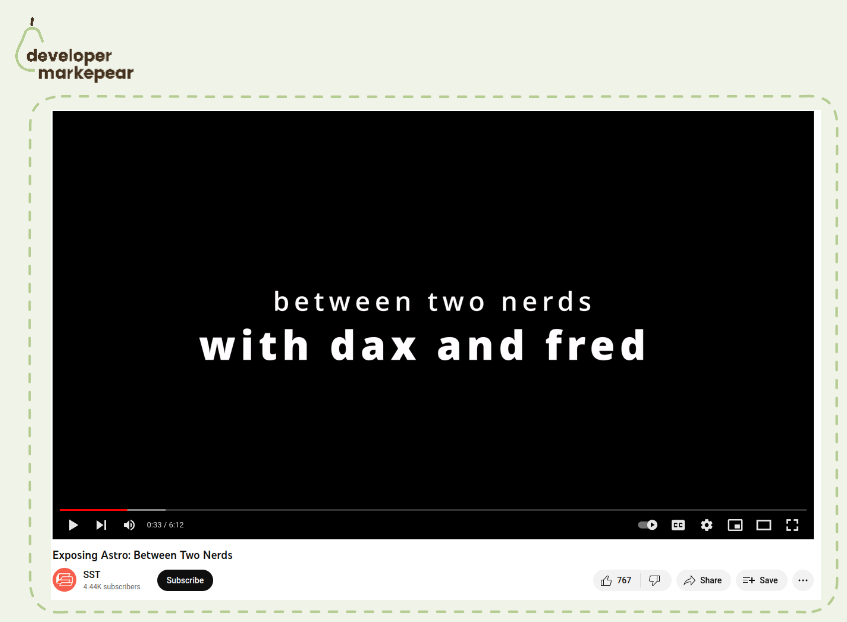
This is one of the most interesting content pieces I have seen in dev tools recently 👇
Comes from @SST and believe it or not is a comedy video created to promote integrations.
That's right.
So SST integrated with Astro and instead of creating "just another how-to use X+Y" video they created this:
It was a fun brand play but got way more views than a tutorial ever could.
And it connected with their audience in a human way that will be remembered (and shared).
Nice.

Action-focused copy is usually better than "sign up".
But sometimes it is hard to find a good copy for this.
Some teams like Vercel or Auth0 do "Start building "
But that doesn't always work.
I really like this "Get API keys" CTA copy.
Now for the Hero section I really like those two CTAs:
Really great job imho.

Need one more call to action idea for your dev tool blog?
How about starting an article with it?
Sounds weird but if done right it can work. Even with devs (or maybe especially with devs).
Earthly did and they are known for great dev-focused content.
Ok, so how does it work?
You start your article with a contextual call to action where you explain:
And then you let people read.
Those who find the topic important will remember you and/or maybe click out to see more.
I like it. It's explicit, transparent, and actually noninvasive.

Funny dev newsletter CTA. From shiftmag .dev by Infobip.
It starts with a chuckle-worthy:
"Sarcastic headline, but funny enough for engineers to sign up"
Then they follow up by disarming the "is that spam" and building more rapport with:
They end with an alternative call to action. RSS feed.
Most newsletters don't do RSS.
But for many devs RSS feed is the preferred content subscription.
Great job!

Awesome sponsorship ad from Trieve in the Cassidy Williams newsletter.
Not sure who wrote it but it must have been a dev ;) It is just so refreshingly to the point.
💚 What I like:
This ad does it so gracefully and quickly it is just hard not to love.

"How fast do you ship?"
Not many dev tools answer that on their homepage. PostHog does.
In a typical (enterprise) sales process, people often ask:
And you show them the roadmap or get someone from the product on the next call.
But I haven't yet seen dev tools talk about it on their homepage.
But why not?
Devs who want to buy self-serve want to know it almost just as much.
After all, they won't be able to twist your arm to build that custom feature cause "we are your biggest client and we need it".
I like it, it builds trust, it shows me you are transparent,
And it shows me that those features I can see on the public roadmap will come true.

Make a {X} cry in 5 words or less.
Great Linkedin (or Twitter) post format.
This is one of those fantastic self-selecting mechanisms as well.
People who understand the joke are the people you are looking for.
You may get the exact people you want to follow your profile.
With a nicely targeted joke.
Love it.
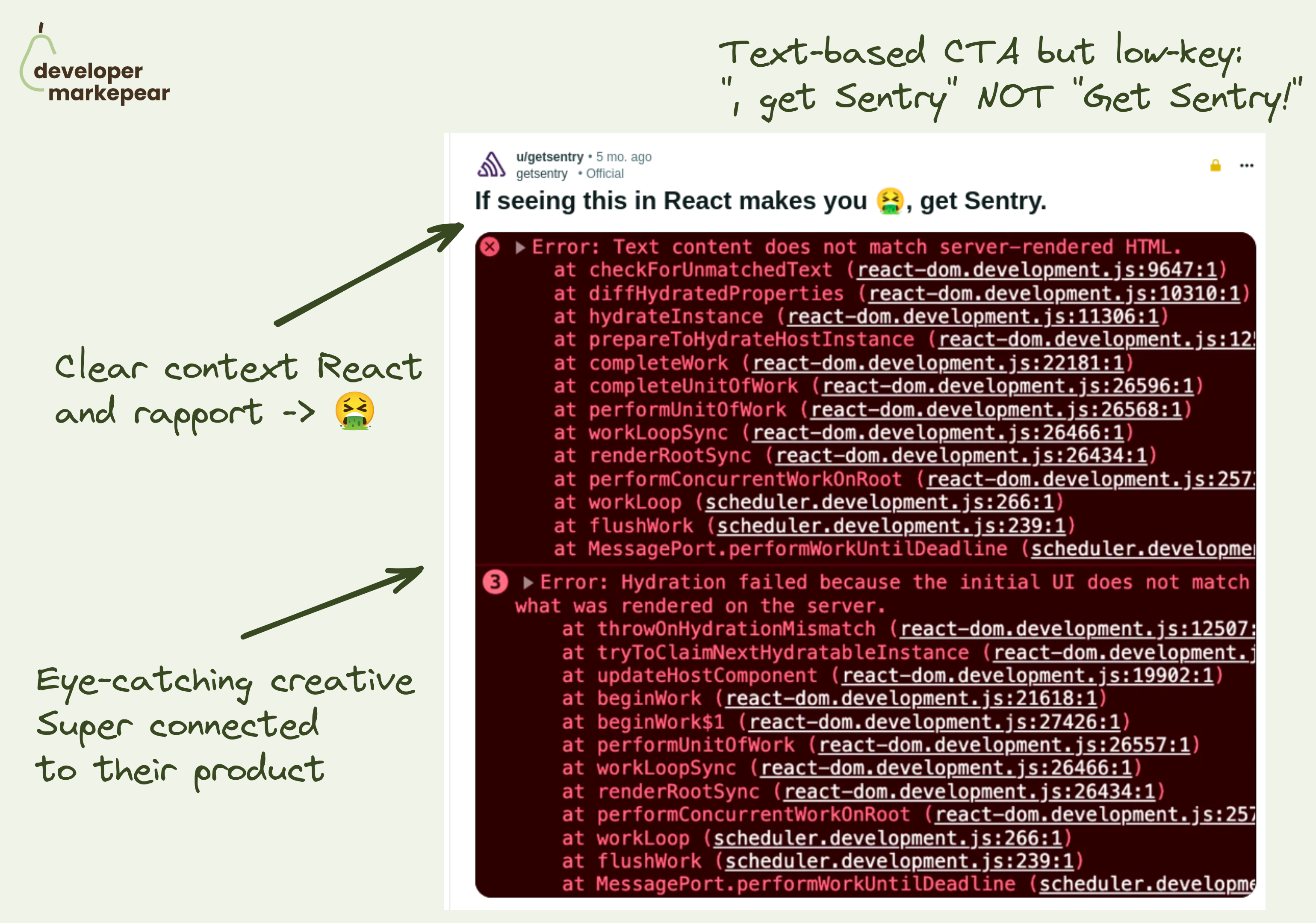
I really like this Reddit ad from Sentry.
Powerful simplicity.
They don't do:
• long value-based copy
• fancy, in-your-face CTAs
• creative that feels "professional
They go for:
• focus on the pain
• creative that speaks to that pain
• low-key CTA ", get Sentry" rather than "Get Sentry Free!"
• building rapport with the dev with copy "If seeing this in React makes you 🤮"
And through simplicity and focus they deliver a message:
• Stack traces in React are not much fun
• They seem to understand that
• Sentry helps you solve that
Good format.

Mux does a few things beautifully in this header.
Value proposition:
Animated visual that is really good for dev tools:
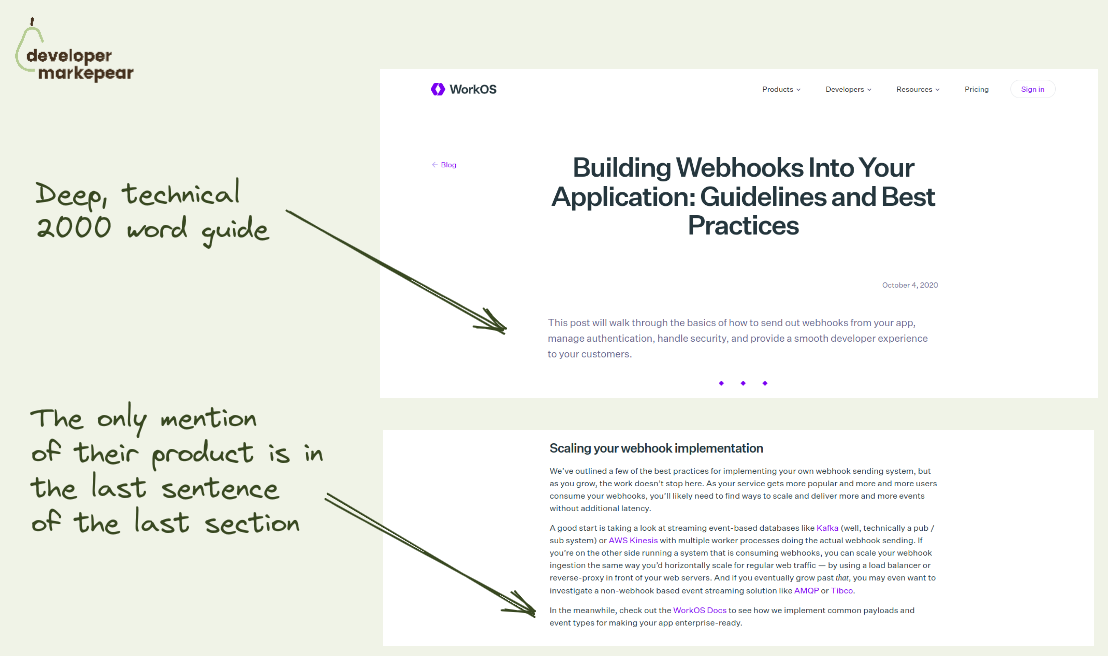
This is how you write dev tool JTBD blog posts.
Masterclass of writing this type of content from @WorkOS imho.
Deep 2000 word guide that explains how to add webhooks the your application.
Goes into examples, best practices, everything.
One thing it doesn't do?
It doesn't push the product left right and center.
In fact, the only CTA is hidden in the very last sentence of the very last section.
Why?
Because most likely, the reader's intent is around understanding the problem at this point.
They want to understand what adding webhooks to their app really means from the practitioner's standpoint.
And they did that beautifully.
Could you have pushed the product a bit more? Sure.
But by answering the actual questions devs came here for they managed to build trust.
And I am sure got their fair share of click-throughs and signups anyway.
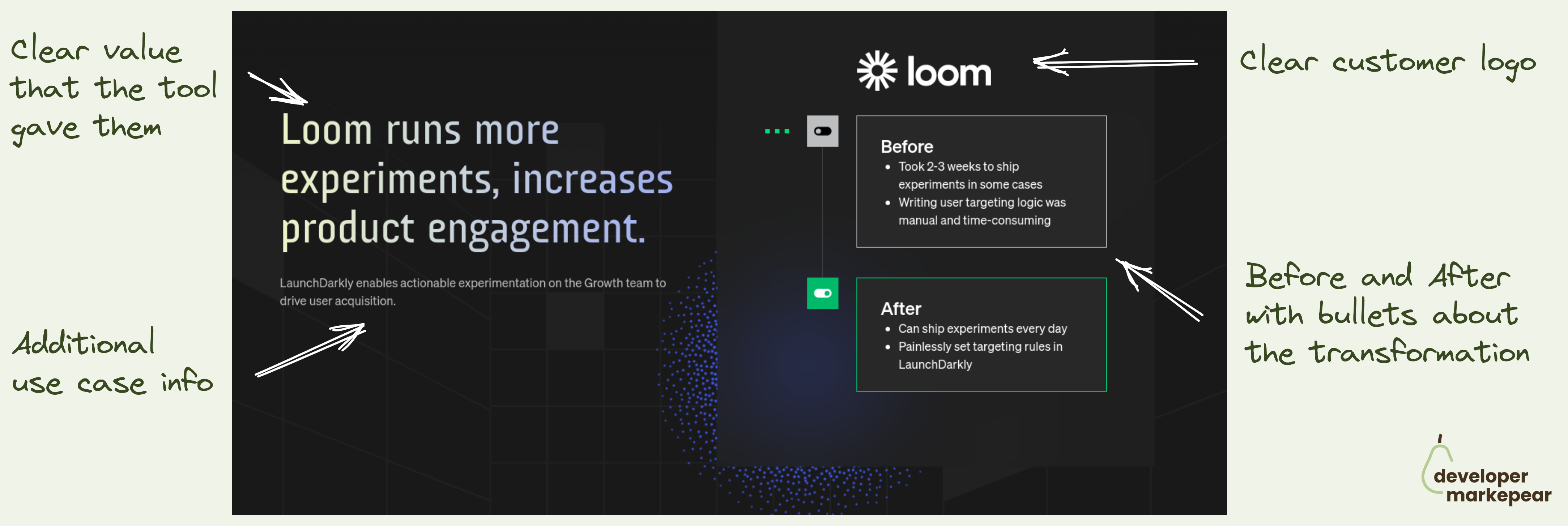
Looking for a good dev-focused case study format?
People tell you to follow a classic Hero > Problem > Solution > Results.
They tell you to show numbers, talk value, etc.
And it is true. Great format.
But packaging this for devs is hard.
For example, putting numbers in there, and framing it in a "save 28min every week" is a recipe for losing trust with that dev reader.
That is if you can even get those numbers from your customers.
I like how @LaunchDarkly solves it.
Hero section:
Case study body:
They keep the content down to earth and devy but still frame it in a value-focused way.
I like that that they speak in the currency that devs care about.
Wasted time.
Before: "Took 2-3 weeks to ship"
After: "Can ship experiments every day"
The cool thing is you could actually use this hero section format and then have a more technical user story below. By doing that you could speak to the why and how.
That depends on your target reader for this page of course.
Anyhow, I do like this format and I am planning to take it for a spin.

With infrastructure tools, it is notoriously difficult to show people the value quickly.
To really see it they would need to set up everything at their company infra, create dashboards for their use case, and so on.
A lot of work.
That is why creating a sandbox experience is a good way of giving people a taste.
I like the way Axiom calls it a playground and says "Play with Axiom" and "Launch playground".
This copy is good because:

This is one of the more devy blog designs I've seen in a while.
It has this docs-like feel.
But is just a bit more fun and loose than most docs would allow.
Here is what I like:
And if your posts are code-heavy, then a docs-like experience is where you want to be anyway.
But you can spice it up with things that wouldn't fit the docs.
Like a Twitter/X embed or a meme.

This is a really clever billboard campaign.
Show don't tell they say.
And Segment did exactly that by putting billboards with the wrong location printed on them (LA in SF etc).
The theme/message was "What good is bad data?" which was exactly what they wanted to convey.
What I like about is the alignment between:
This is hard to do imho so big kudos to them 🎉!
Downside?
Reportedly many folks who saw billboards didn't get that it was intentional and Tweeted at them about the error.
Or maybe they were next-level jokers...

Just wanted to share this classic dev tool branding campaign.
There is even a book about this from Jeff Lawson at Twilio.
But I recently saw someone share on HN that it got changed to "How can I reduce acquisition costs by 65%". Made me a bit sad.
But perhaps after years and years of working it stopped delivering any additional brand awareness/affinity.
Could they have come up with another flavor of "Ask your developer."?
Maybe. But maybe at their levels of mind share you are playing a different game.
The good thing is, you are not at that stage ;)
And f you pull off something that is 1% of the success of that famous Twilio campaign you can make your brand noticed and remembered.
I know we are in the year of doing what brings results right now. And branding campaigns may not make the cut.
But maybe we can (and should) afford to do something that helps us deliver that pipeline next year or a year after that?

Understand who is reading. Add social proof that speaks to them.
Social proof is about showing people/companies who are similar to the reader that they got success with the tool.
Company logos can be good if your reader knows and likes those companies.
But if those are random companies, I am not sure how much value does it bring.
Devs care what other devs who use your product have to say about it.
That's why I like testimonials.
Not the crafted, clean ones with features and values.
But the real stuff. Real devs sharing real stories.
Bonus points for "Okay, I get the point" button copy.
It changes from "Show more" when you click.
Nice!

Sometimes your product just wins on price.
I like how New Relic owns it on this page:
After reading this I'd trust them to give me a solid price estimate and that it will likely be cheaper than Datadog.
Obviously price is not the only reason why we choose tools, but if that was a problem I had with Datadog, they have my attention.
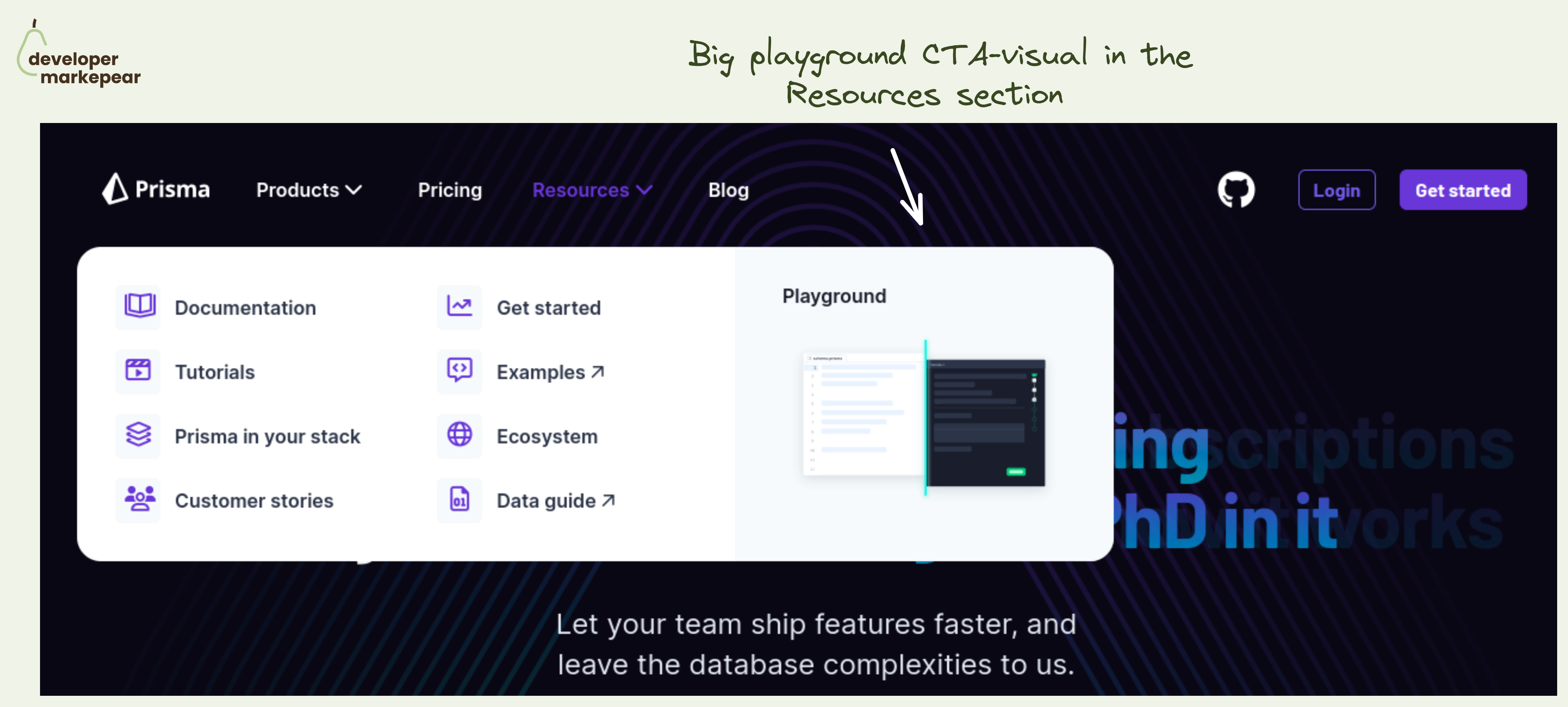
Simple yet powerful CTA in the navbar resources section.
The resources section in the navbar is mostly navigational. Well, the entire navbar is ;)
But you always have that one action that is more impactful than others.
💚 And I think that a Plauground is a great option. You get people to see how your product works. You let people play with it and see for themselves.
Not many next actions can be as impactful as getting people to experience the product.
Especially if you are a heavier infra tool that people cannot really test out in that first session. I mean, you won't really create a realistic example of your core database in 15 minutes to see how that new tool that you just saw works.
🔥 Making this CTA "big and shiny" and showing a glimpse of what will happen after clicking is great too.
🤔 2 changes I'd test out:
But the core idea behind making the playground your core navbar resource section CTA is just great.
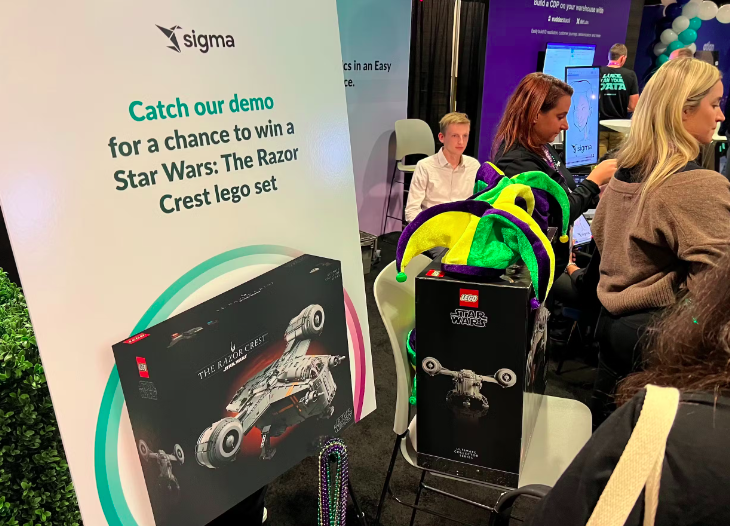
Instead of giving away hundreds of small things that people will forget give away one thing that leaves an impression.
And a huge LEGO set is a great candidate for that one big thing. There is a big overlap between devs and folks who love LEGOs. They are both builders after in their hearts.
Now, some important considerations:
You need to commit to it too.
Don't do 3 different things like that at a conference. Focus on one play like this at a time and try other cool ideas at another conference.
Folks from Sigma Computing ticked all these boxes. Love it!

How to present many features at once?
Sometimes your dev tool has many features/products that you want to show.
❌ Showing all of them as separate sections doesn't work with more than 3. It just gets too long very quickly.
✅ You can go with the tabs pattern where each tab has copy+visual for a feature.
💡 But there is another option that makes a ton of sense when you have many features to show.
Interactive tiles of different sizes.
💚 I like the implementation of that pattern coming from Clerk:
That pattern can work really well on blogs or learning centers too but I think we're going to see more of it on dev tool websites.

Beautiful growth loop that uses GitHub PRs to spread awareness even internally in the org.
And just one dev needs to sign up for the product to start it.
Works like this:
Heard about it on Lenny's podcast episode with Ben Williams (the story starts at 20:53)
... and then signed up to see the actual PR.
I really love this one as it allows you to spread inside the organization even if everything is on-prem and you never get to see it.
Those PRs are just working behind the scenes doing marketing for you.
Brilliant!

There are a lot of boring vendor t-shirts at conferences.
And they get boring results.
I like this bold design from GitGuardian:
Nice.
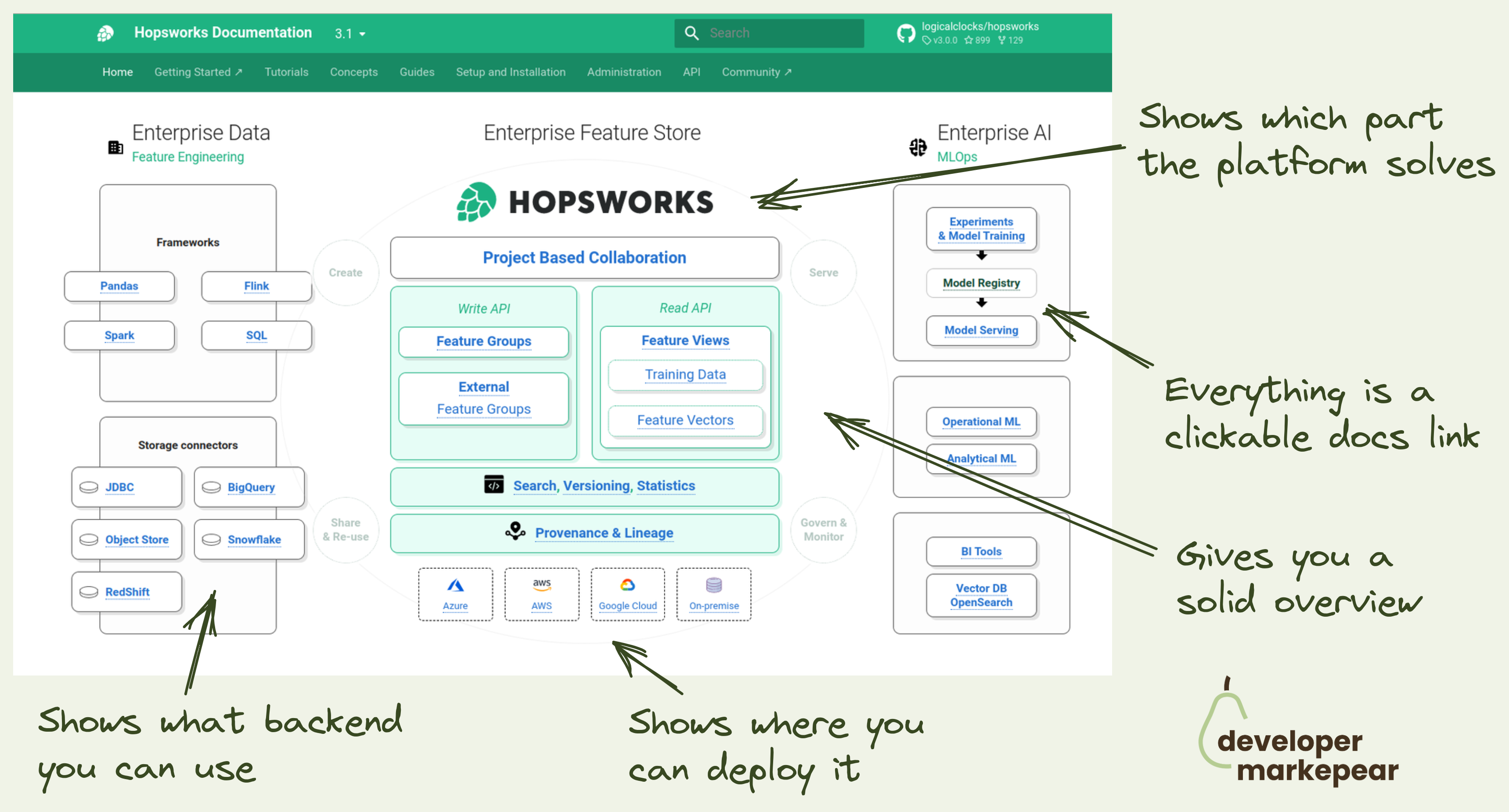
A docs header worth a thousand words.
For a dev platform or infrastructure tool it is hard to explain where you fit, what you do quickly, and how you connect to existing components quickly.
Hopsworks docs team does a great job here.
So instead of using words, they use a diagram:
All of that in a single diagram.
Now that is a dev-focused header visual.

Hacker News developer audience doesn't love promotion to put it mildly.
But some dev tool companies manage to make this audience their biggest ally.
Fly.io is one of those companies.
And they had a super successful product launch a few years back.
So how did they do it?
Let's go through these in detail.
Who are you? Why should I listen?
What is the problem really?
What does your product do and how does it work?
Speak "dev to dev"
By doing it this way you have a chance of gaining love from the prolific HN crowd.
Fly.io definitely did, and is still reaping rewards with constant HN exposure.

Funny and memorable competitive billboard ad from @Statsig 👇
You have a big incumbent, everyone knows them. Use it to anchor your brand.
And tell the story of how you do things differently.
👀 But first, make people see you. And remember you in the next conversation when the big known brand or a category comes up.
And being funny is one of the best ways of getting attention and being remembered.
💚 I love how folks from Statsig did it here. Such a playful pun on the feature flag category incumbent Launch Darkly. Job well done.
Btw, this was shared by Oleksii Klochai in the Developer Marketing Community (you joined yet?).

Dorky joke right?
But it does two very important things beautifully.
It gets a smirk (from some people) and when it does you know you just moved someone closer to your brand.
It has a clear CTA which is hard to do with joke-format ads.
This subtle call to conversation/check us out does the job.
Love it!

How to get people to sign up for your office hours?
Why not put it on your docs homepage?
Btw, I really like the concept of office hours.
You get your devrels or product to do those weekly and then you just have to figure out how to get people there.
Classic options are to put info in onboarding sequences, in the app, or on the website hello bar.
But Flatfile had another idea. They put it in their docs homepage header.
I find this idea brilliant as many people who browse your docs (especially for the first time) are in that evaluation mode and would actually want to do that.
Plus calls to action in the docs get more respect by design ;)

How to do a dev-focused brand video and get 10M+ views?
Making a memorable brand video is hard.
Doing that for a boring tech product is harder.
Doing that to the developer audience is next level.
Postman managed to create not one but three of those brand videos that got from 4M to 10M youtube views.
The videos I am talking about are:
So what did they do right?
Honestly, I am not exactly sure what special sauce they added but those are just great videos that you watch.
And I definitely remember them and the company which is exactly what you want to achieve with brand ads.

How easy it is to get started is a big conversion factor for any dev tool.
Devs want to test things out and if it is hard to do they will be gone testing a competitor that made it easy.
And so a good how-to section on your homepage can make a big difference in getting devs to that first experience.
Appsmith does it beautifully with their 1-2-3 How-to section:
It is so engaging and just beautifully designed. And the CTA to additional resources like integrations, widget library, and docs make the message land. I do believe it is easy to set this up.
Great pattern to copy-paste imho.

Most dev tools have two deployment options:
And then companies present it on their pricing page with some flavor of two tabs.
And you need to name them somehow.
And how you describe those things sometimes adds confusion for your buyers:
I like how nice and simple solution Retool used on their pricing page:
Explicit, obvious and to the point.
Love it.

OK, the best way of getting GitHub stars is by creating a project that solves real developer problems well.
I assume you have done that already and the metric that people love to hate ⭐ is growing organically.
What do you do now?
I mean you got to ask people in one way or another.
Many companies put it in their navbars or hello bars.
Posthog adds a sticky banner at the bottom of the page that follows you as you scroll.
It also shows a start count which at their size (11k + stars) acts as social proof.
You can close it and the next time you visit the page it will be off not to push too much.
I like the concept makes sense to test it out this way imho.

How to write a "What is {MY CORE KEYWORD}" article that gets to the top of HackerNews? 👇
First of all, almost no one succeeds at that as you write those articles for SEO distribution, not HN distribution.
To get an SEO-first article on HN your content quality bar needs to be super high.
But you can do it.
PlanetScale managed to get their "What is database sharding and how does it work?" on the orange page (kudos to Justin Gage!).
Here is what was interesting about that article:
𝗦𝘂𝗽𝗲𝗿 𝘁𝗼 𝘁𝗵𝗲 𝗽𝗼𝗶𝗻𝘁 𝗶𝗻𝘁𝗿𝗼.
• ❌ No "In today's fast-paced data-driven world enterprises work with data" stuff.
• ✅ Just "Learn what database sharding is, how sharding works, and some common sharding frameworks and tools."
𝗛𝗶𝘁𝘁𝗶𝗻𝗴 𝗸𝗲𝘆𝘄𝗼𝗿𝗱𝘀 𝘄𝗵𝗶𝗹𝗲 𝗯𝘂𝗶𝗹𝗱𝗶𝗻𝗴 𝗿𝗮𝗽𝗽𝗼𝗿𝘁 𝘄𝗶𝘁𝗵 𝘁𝗵𝗲 𝗱𝗲𝘃 𝗿𝗲𝗮𝗱𝗲𝗿.
💚 Speaking peer to peer, not authority-student:
• "You’ve probably seen this table before, about how scaling out helps you take this users table, all stored on a single server:"
• "And turn it into this users table, stored across 2 (or 1,000) servers:"
• "But that’s only one type of sharding (row level, or horizontal). "
𝗨𝘀𝗶𝗻𝗴 𝗷𝗮𝗿𝗴𝗼𝗻 𝗮𝗻𝗱 𝘂𝗻𝗱𝗲𝗿𝘀𝘁𝗮𝗻𝗱𝗶𝗻𝗴 𝘆𝗼𝘂𝗿 𝗮𝘂𝗱𝗶𝗲𝗻𝗰𝗲
Things like:
• "Partitioning has existed – especially in OLAP setups"
• "Sifting through HDFS partitions to find the missing snapshot "
𝗔𝗰𝘁𝘂𝗮𝗹𝗹𝘆 𝗲𝘅𝗽𝗹𝗮𝗶𝗻𝗶𝗻𝗴 𝘁𝗲𝗰𝗵𝗻𝗶𝗰𝗮𝗹𝗹𝘆 𝗵𝗼𝘄 𝘁𝗵𝗶𝗻𝗴𝘀 𝘄𝗼𝗿𝗸
🔥 Look at the section "How database sharding works under the hood" with subsections:
• Sharding schemes and algorithms
• Deciding on what servers to use
• Routing your sharded queries to the right databases
• Planning and executing your migration to a sharded solution
🎁 𝗕𝗼𝗻𝘂𝘀: 𝗽𝗹𝘂𝗴 𝗶𝗻 𝘆𝗼𝘂𝗿 𝗽𝗿𝗼𝗱𝘂𝗰𝘁 𝗴𝗲𝗻𝘁𝗹𝘆
Section "Sharding frameworks and tools" shares open-source tools (every dev, but HN devs in particular like OS projects).
And there as an info box, you have the info that Planetscale comes with one of those OS projects deployed.
Just a beautifully executed piece of content marketing.

I really love this hand-drawn feel.
It makes it super authentic.
Also, starting from scratch (not a ready diagram) makes following it more fun and less overwhelming.
Great stuff.
BTW the tool used for this is called excalidraw.com
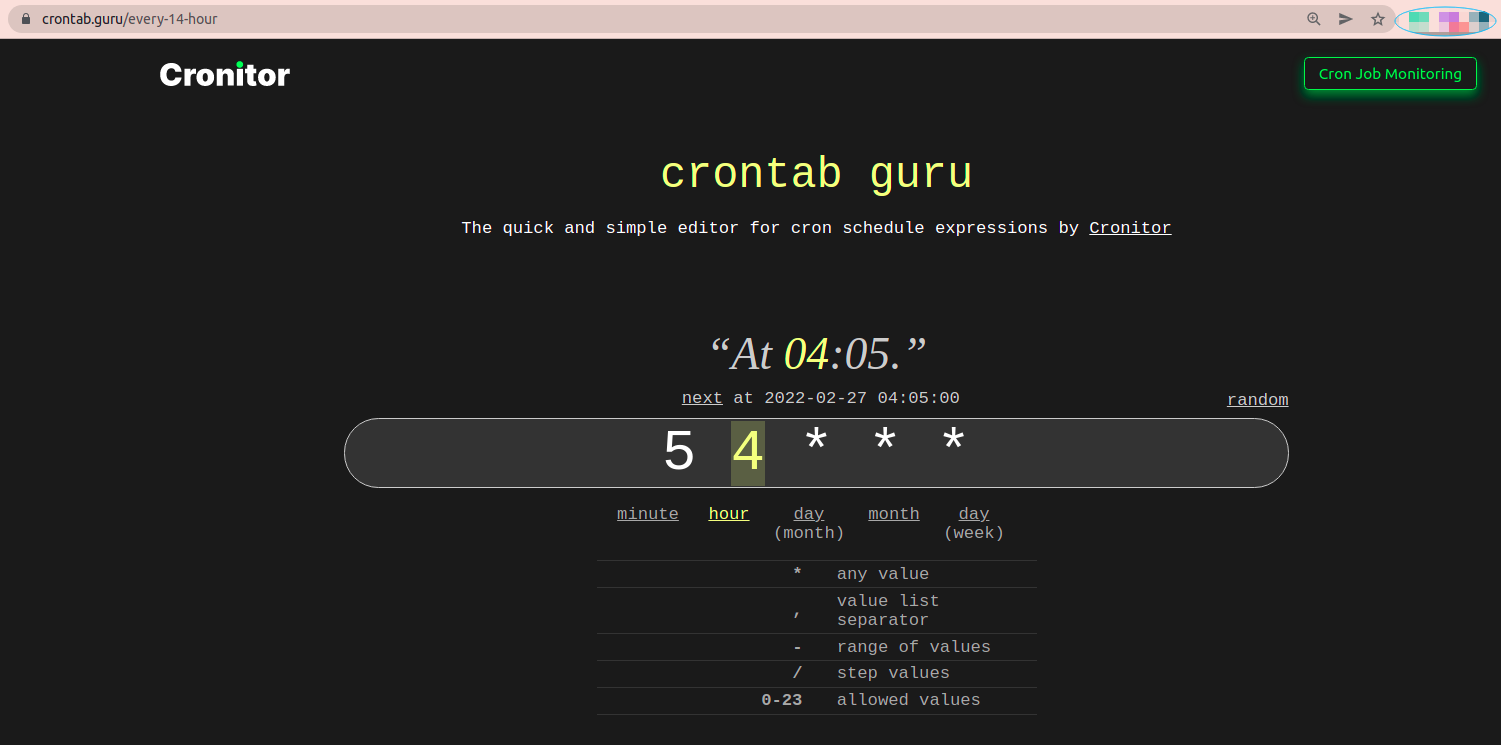
Great SEO tactic.
What folks from Cronitor did is:
This can be used for many dev-focused tools as by definition they use commands which can be templated.
I've heard about it originally from Harry Dry over at https://marketingexamples.com/seo/cronitor
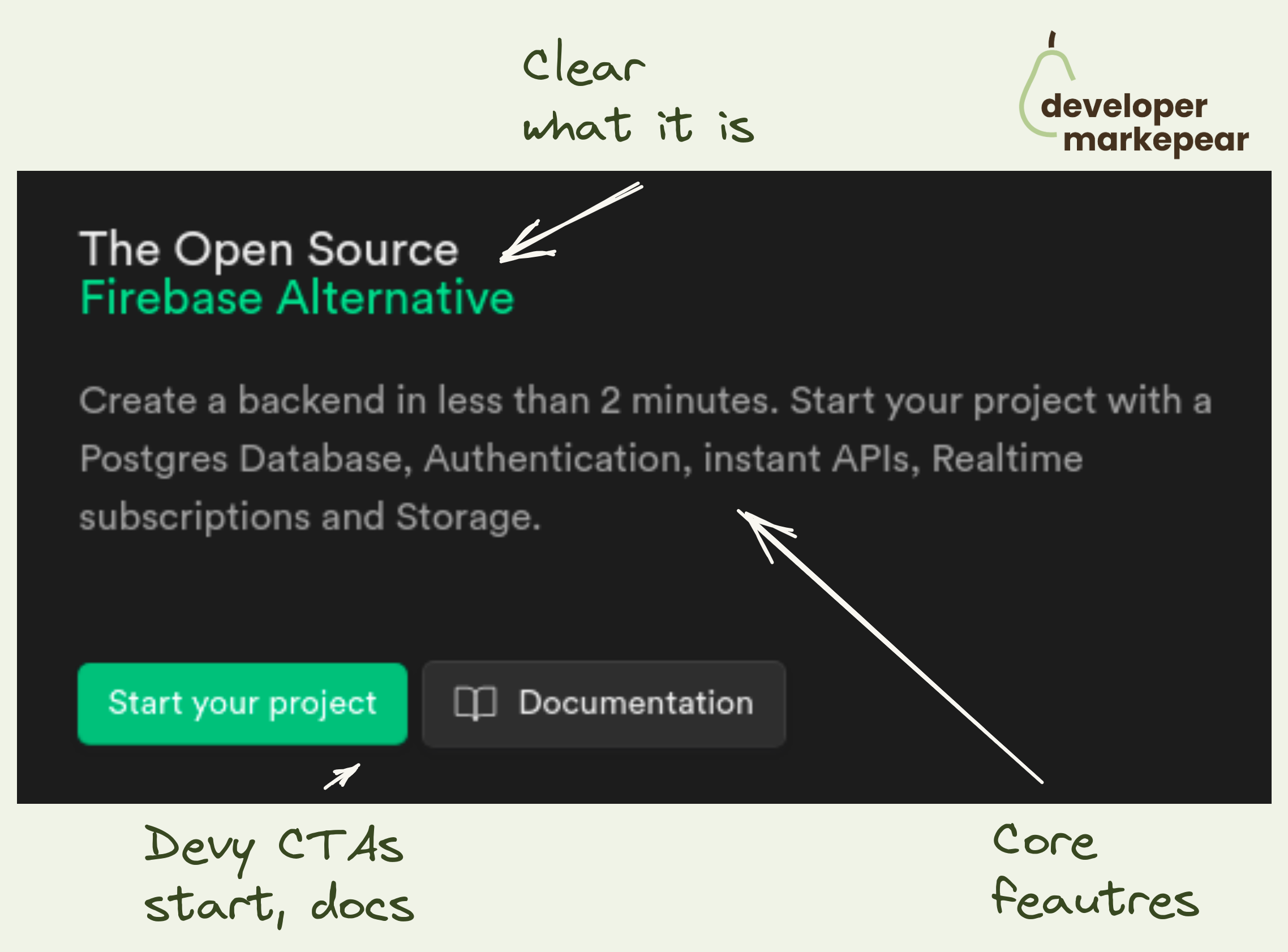
Say what you do and how you do it.
What:
How:
CTA (bonus):
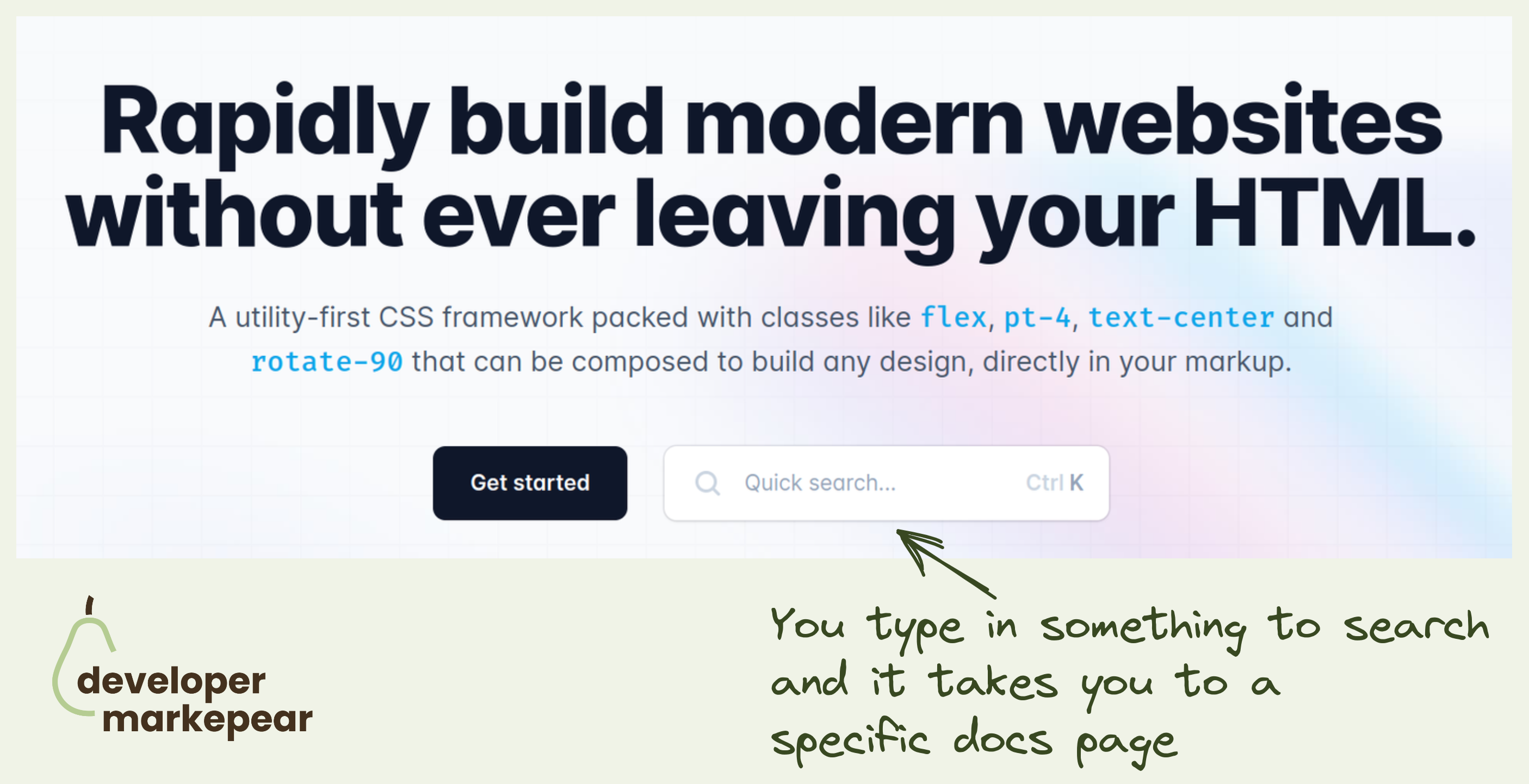
"See docs" is one of my favorite secondary CTA on dev-focused pages.
TailwindCSS takes it to the next level by inserting docs search right into the header CTA.
This takes devs directly to the page they are interested in rather than have them try and find things for themselves.
They could have searched the docs in the docs, of course.
But this is just this slightly more delightful developer experience that TailwindCSS is known for.

Devs have a love/hate relationship with "Book a demo" call to action.
Mostly hate though.
Especially if what they want is:
Let's just say that sitting through an hour demo call with a salesperson just to get the pricing is not what most devs love to do with their time.
But there are moments in the buyer journey when devs do want to have that live session:
Then, having a live session/demo is the fastest way to move forward.
@PostHog handles this dev journey reality nicely with:
This approach solves both scenarios really nicely.

Copy that lands makes a huge difference in dev tool website conversion.
Earthly proved it with this "tiny" change.
So I am a huge believer in good copy.
Not the clever one but the one that is written with words that your customers use.
That is rooted in product and research.
But I often hear devs or founders say things like "it's just copy".
It is not "just copy" it is your message, it is your positioning.
It is the difference between "cool, let's try it" and "now for me, whatever".
So some time ago I came across this article from the Earthly CEO Vlad Ionescu.
He shared that at some point they decided to run this A/B test with just a "tiny" change.
They changed the word "CI" -> "Build" across the homepage.
And their core website conversion doubled.
So next time you work on website copy give it some more thought and you may be surprised that "just copy" made a huge difference.

I like this idea of showing how your dev tool works.
With developers, you almost have to explain how it works on your homepage.
Many products do some version of Step 1 -> Step 2 -> Step 3 -> Success.
I really like how @SST approached it with a timeline.
I find it more engaging than those disconnected steps.
And when I follow this journey the final and logical step is to try it out. Get started.
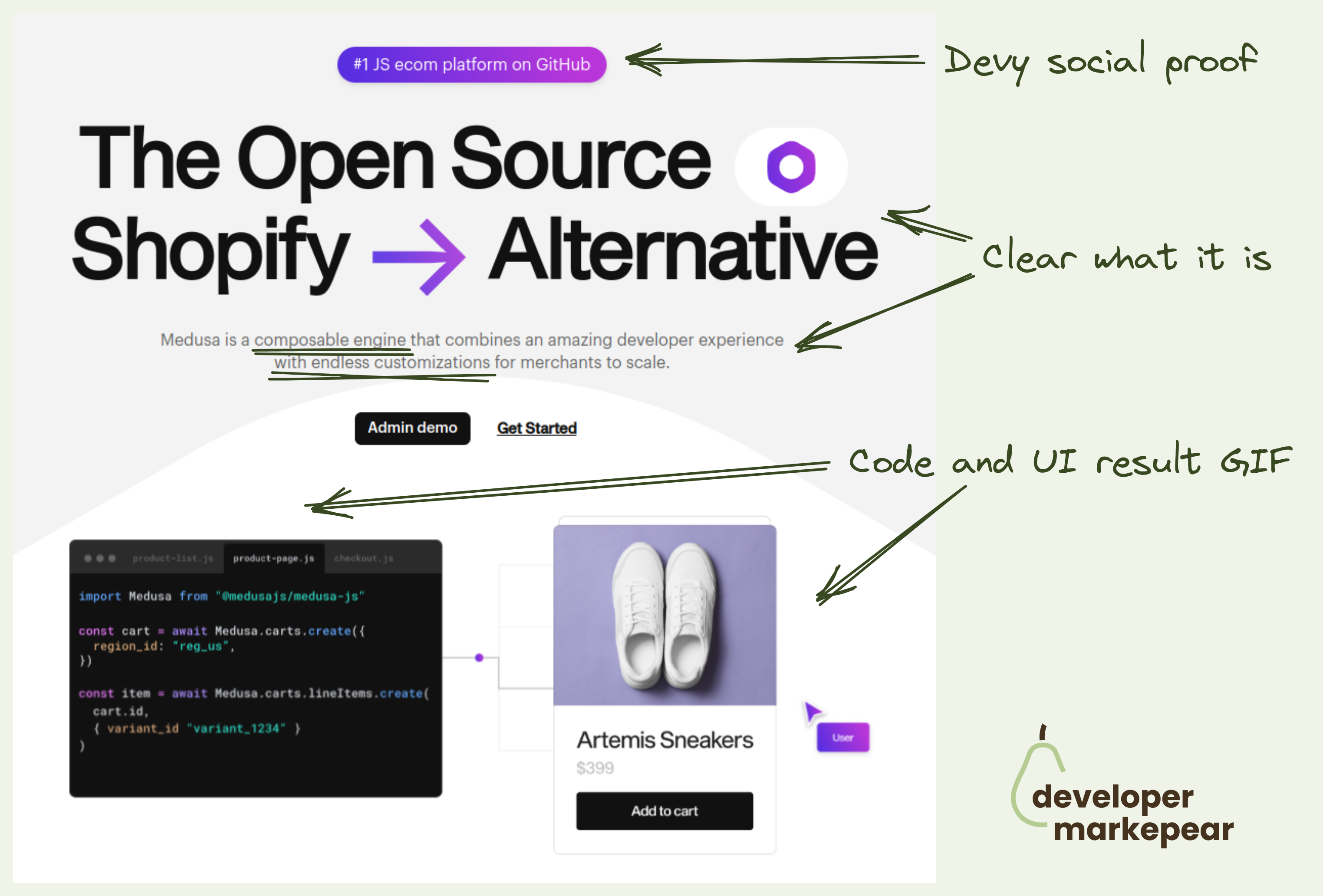
There are many things that I like about it.
Overall with very little effort, I understand what it is, and what it does.
And I can go and dig deeper for myself or spread the word with my circles.

Algolia gets over 80% of referral traffic from a single free tool they created called Search Hacker News.
But why does it work so well for them?
Hacker News doesn't really have a native search experience.
Algolia gives devs an amazing search experience out of the box.
So folks from Algolia created their own website where you can search Hackernews... with Algolia search engine.
Of course, when you click on "Search by Algolia" you get directed to the website and can learn how to set up a similar search, which you have just used yourself.
What I love about this:
And looking at the results it delivers.

Great example of programmatic SEO from Snyk.
They created a page called snyk advisor.
It is a repository of pages about open-source packages.
Each page is created automatically out of publicly available information.
Enhances it with Snyk-generated security scans and reports.
It builds awareness for other Snyk products in the security space.
A lot of those pages rank high in google for the {package} keyword which is incredible.
And when people land on the package report page the CTAs to Snyk products push conversions.

How do you make your dev tool pricing simple?
I really like this one.
Saw someone share a pricing page from Userfront some time ago and really liked it. They changed it now but I really like the thinking behind the older version.
It is just remarkably simple while hitting all the boxes:
Just a very good baseline.

A great example of a dev-focused Linkedin post format from Khuyen Tran 👇
What I like about this:
Just great job!

I like how it has a proper "hero section" feel to it but it adds a developer-focused twist:
The rest of the Readme is great as well but the hero section is gold imho.
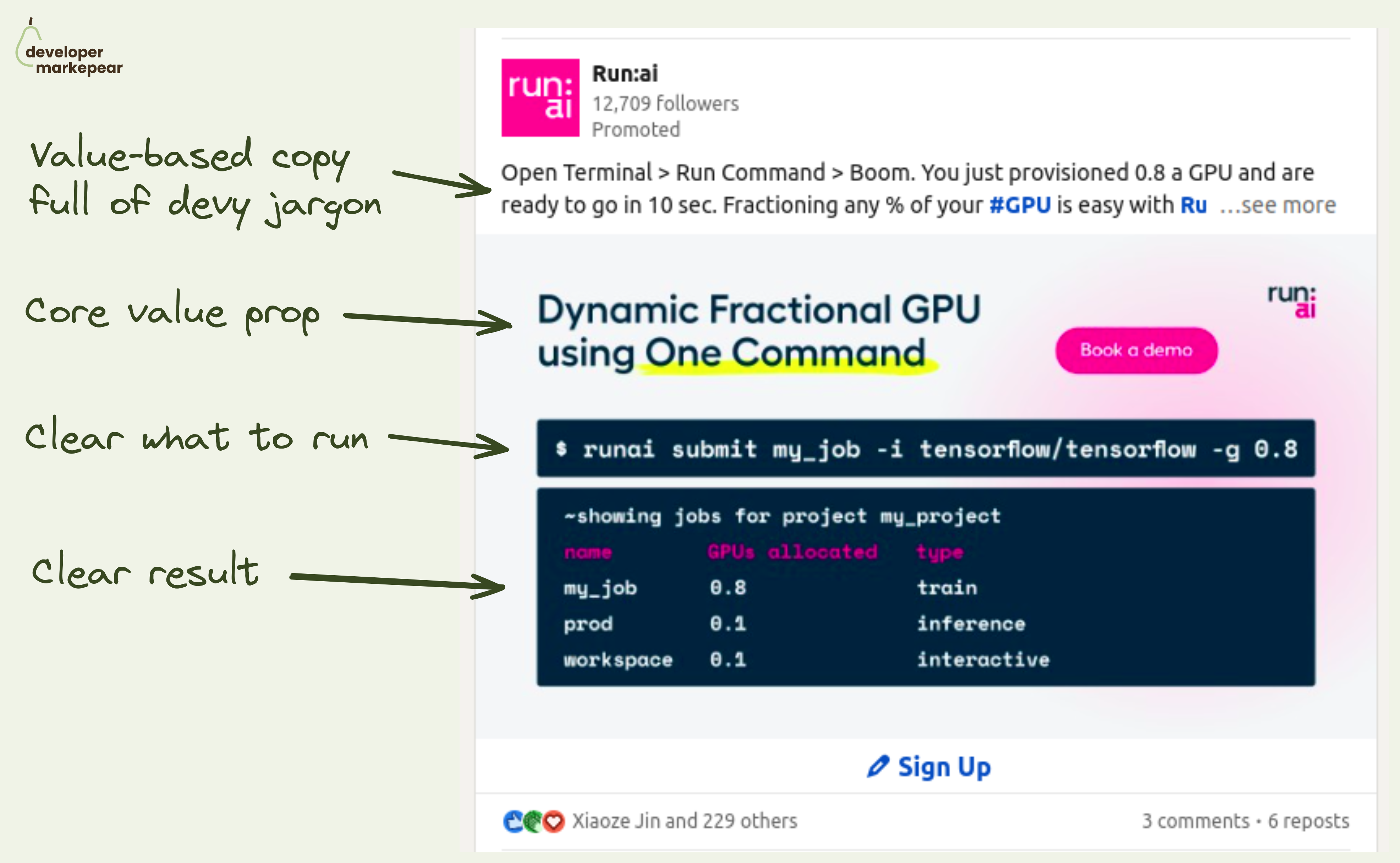
𝗔𝘁𝘁𝗿𝗮𝗰𝘁𝗶𝘃𝗲 𝗮𝗱 𝗰𝗿𝗲𝗮𝘁𝗶𝘃𝗲 𝗳𝗼𝗿 𝗮𝗻 𝗶𝗻𝗳𝗿𝗮 𝗽𝗿𝗼𝗱𝘂𝗰𝘁 𝘁𝗵𝗮𝘁 𝗿𝘂𝗻𝘀 𝗶𝗻 𝗮 𝘁𝗲𝗿𝗺𝗶𝗻𝗮𝗹?
Hard, but Run.ai did that.
Infra products are not "obviously cool".
There is no shiny UI, no happy people wearing your sneakers,
So what do you show on your ads?
First off, the rules still apply:
• Catch your audience's attention
• Say what you do in their language
• Better yet, show how it actually does it
And Run.ai ai and MLOps infra tool managed to create a beautiful Linkedin ad IMHO:
• They catch attention with the code visual
• They say what they do quickly with "Dynamic Fractional GPU using One Command"
• They extend on that in the post copy with an action-driven "Open Terminal -> Run Command -> Boom"
• The code shows what it feels like to use the tool
• And it shows you the result -> fractional GPUs
Job well done!
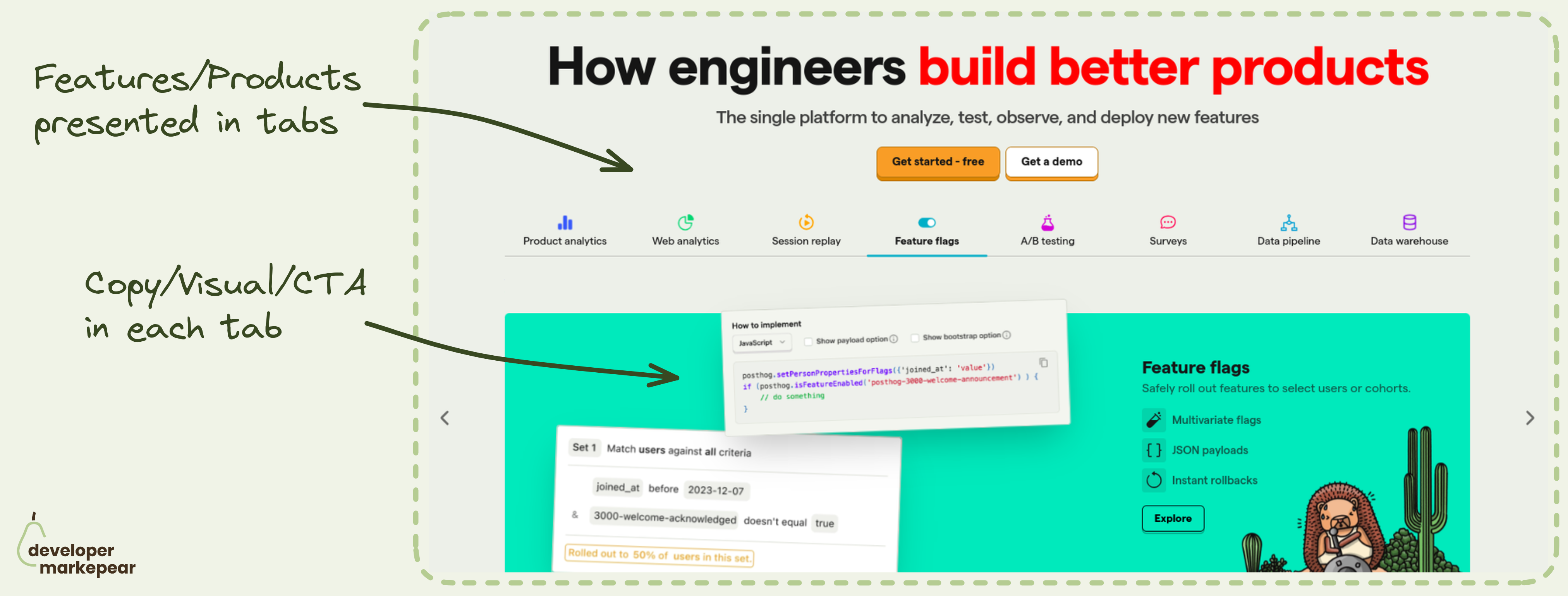
Which feature/product to show in the header?
How about all?
Many dev tool products are feature-rich. And you want to show those awesome features.
But it is easy to overwhelm the reader when showing so much info.
That is why I really like the header tabs pattern that @PostHog uses:
This pattern is especially powerful when you want to communicate completeness.
Posthog definitely wants to do that. If you are on that train I'd strongly suggest considering/testing it.

This is a sandbox experience folks over at Sentry.io created.
I like the navbar CTAs with a big "Documentation" button in there.
Reminds me that I can go and see it when I need it.
But I also get those conversion focused "Request a demo" and "Start a trial" for when I am ready.
On top of that I get tours and help in the sidebar for when I get stuck.
.... and the whole thing is gated behind a work email which I don't love.
But having that work email let's you nurture (and Sentry is known for awesome emails).
Plus it does help sales. If anything it is an additional signal for your account scoring models.
But if you are going to gate a sandbox, make sure to show all that value behind the modal like Sentry did.
With that I can feel compelled to type in that email.

Devs are builders.
Make your home page for builders.
Go directly into the "how" instead of the way.
Many devs when they land on your home page, already know the "why".
I love that it:

Thinking about your next conference giveaway idea?
How about a coconut? Datafold did just that!
Coconut + logo burned on it + a person who can open them up
=
A memorable, shareable, fresh (literally), and wholesome conference experience.
And I bet it didn't cost an arm and a leg too.
It goes to show how creativity matters when planning those things.
Thinking about doing a similar thing in Poland... with potatoes of course ;)
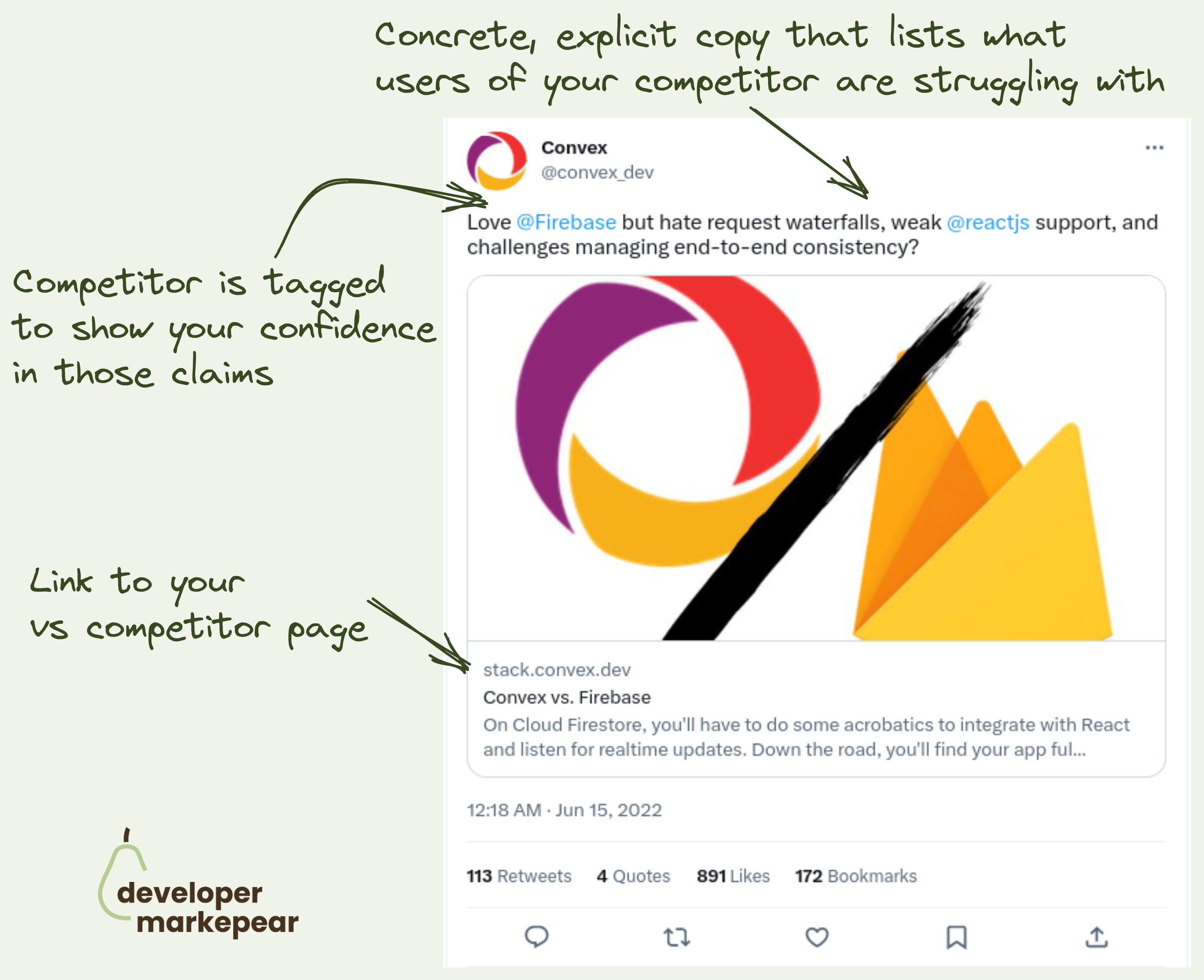
VS competitor ads are hard to pull off with devs. Not impossible though. 👇
So the problem is that:
@Convex does it really nicely here:
And even though this is by a "aggressive" competitor marketing hundreds of devs liked/bookmarked this tweet.
Good job!

A classic "It doesn't suck" campaign.
Afaik, Barebones ran the first version of this campaign 20 years ago and it was a huge success.
It is so simple, it just speaks to that inner skeptic.
It doesn't say we are the best, we revolutionize software.
It says it doesn't suck.
That is way more believable and makes me think that there is a dev on the other side of that copy.
And there is something cool about this message that makes me want to wear it to the next conference.
Good stuff.
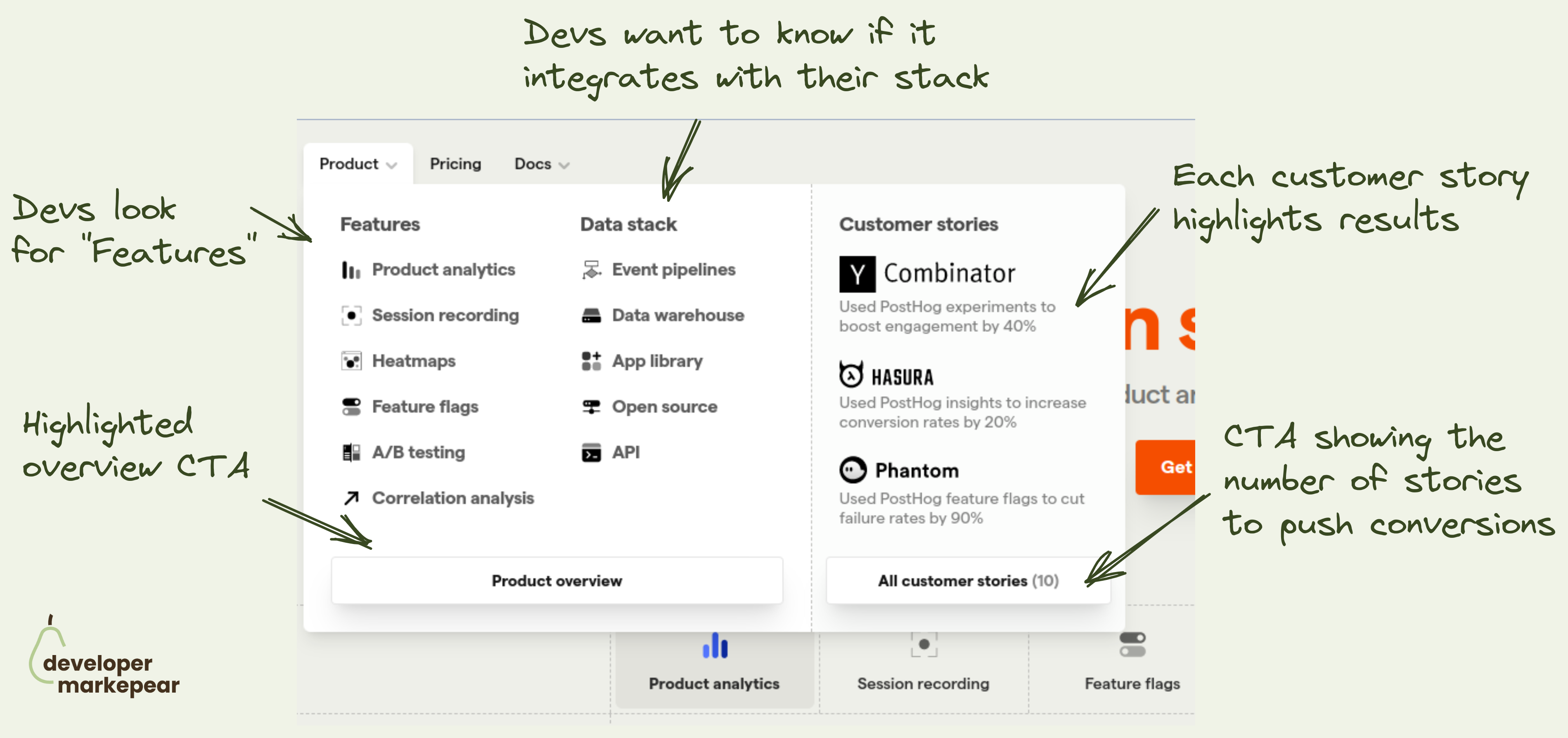
How to design the navbar product tab? This is what @PostHog does 👇
Figuring out what to put in the navbar is tricky:
The "Product" tab is especially tricky.
It can get overloaded with a ton of content.
I like how Posthog approached it:
I like it.

How to communicate the flexible part of your plan?
Many dev tools have 3 plans:
Especially the ones doing some flavor of product-led-sales or open-source go-to-market.
Now, the Team plan is often a self-served version.
And for many dev tools, this part is partially or entirely usage-based.
So how do you present it?
You can just have "+ what you use" and explain it in the big table below.
But if you have just one usage dimension then why not do it here?
Resend does it beautifully communicating right away that it starts at 20$ / month and grows with the amount of emails you send.
Very clear. Very nice.

When selling dev tools you typically have 3 "buyer" levels:
Individual dev:
Team lead:
Org lead:
How does Postman solve it?:
They even go the extra mile. Something I didn't see too often.
They understand their customer's reality and identified one more level between Org and Team.
Basically a department-level unit that probably has multiple teams but is not at the organization/enterprise level.
I really like what they did hear. Solid.